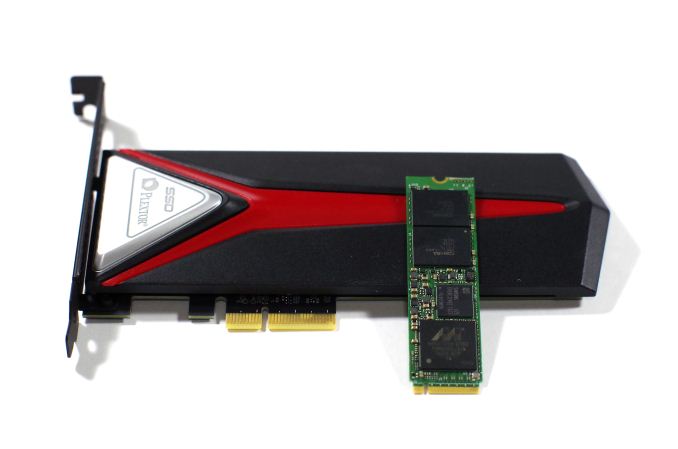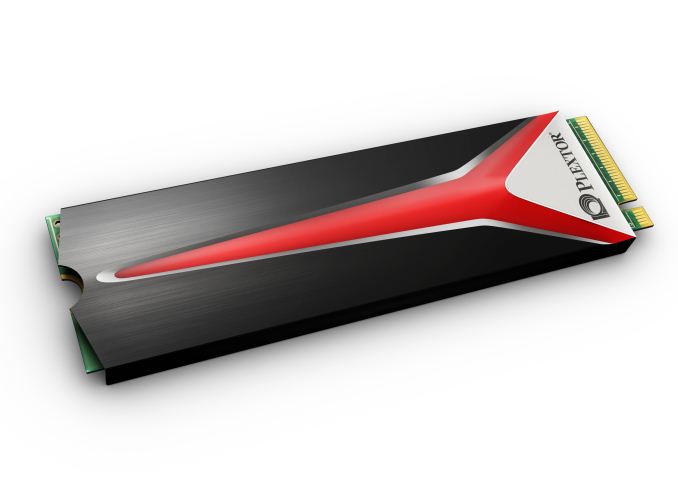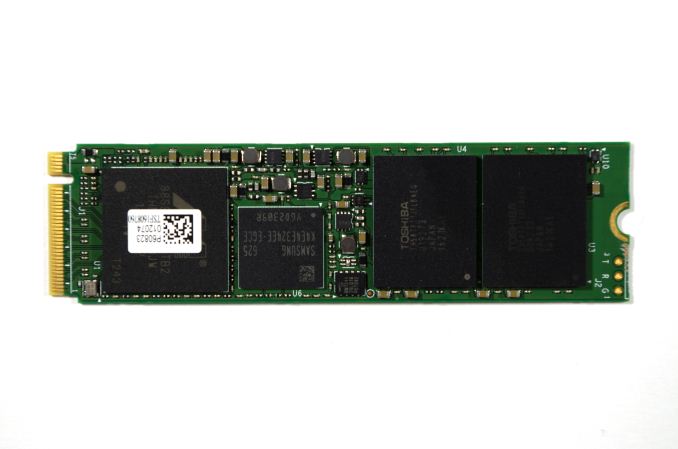The Plextor M8Pe (512GB) SSD Review
by Billy Tallis on December 14, 2016 9:00 AM EST
Plextor first entered the PCIe SSD market in 2014 with the M6e, based on Marvell's 88SS9183 controller supporting PCIe 2.0 x2 but not NVMe. In 2015 they followed it up with the M6e Black Edition that simply provided an adapter card and heatsink for an unchanged M.2 module. They also announced then delayed and eventually cancelled the M7e, which was to use the Marvell 88SS9283 to support PCIe 2.0 x4 connectivity. This year, the M8Pe finally brings a true high-end NVMe SSD to Plextor's product line.
The M8Pe series is available in three different variants, all based on the same M.2 module. The M8PeGN is the simple bare M.2 2280 card. The M8PeG adds a heatspreader that covers the top and sides of the M.2 module. This heatspreader should help alleviate the thermal throttling that all PCIe M.2 SSDs suffer from during sustained heavy benchmarking, but the added thickness will prevent it from fitting in some laptops. Finally, the M8PeY is a half-height half-length PCIe x4 add-in card adapter to house the M.2 SSD under a hefty slab of metal acting as a heatsink, and red LED accent lighting is included along the top edge of the card and under the Plextor Logo on the heatsink.
Plextor M8PeG with heatspreader
The Plextor M8Pe series shares its hardware platform with parent company Lite-On's CX2 client SSD for the OEM market. The controller is Marvell's 88SS1093 PCIe 3.0 NVMe controller codenamed "Eldora", with 8 NAND channels and support for NVMe 1.1 and LDPC error correction. The controller is a triple core design fabricated on a 28nm process. The 88SS1093 was one of the first PCIe 3.0 NVMe SSD controllers available on the open market, and it was quickly adopted for entry-level enterprise PCIe SSDs by companies like Seagate and Micron. The Plextor M8Pe is the first consumer SSD to ship with this controller. As usual, Plextor/Lite-On wrote their own firmware for use with the Marvell controller instead of adopting a reference implementation.
The M8Pe uses Toshiba 15nm MLC NAND flash to provide drive capacities from 128GB to 1TB. Performance specifications are not as high as Samsung's latest generation of NVMe SSDs based on their Polaris controller, but are similar to the earlier Samsung 950 Pro and to Toshiba's OCZ RD400. The Plextor M8Pe has a five year warranty and endurance ratings that are only slightly below that of the Samsung 960 Pro.
| Plextor M8Pe Series Specifications Comparison | |||||
| 128 GB | 256 GB | 512 GB | 1 TB | ||
| Form Factor | M8PeY: Half height half length PCIe add-in card (HHHL) M8PeG: M.2 2280 with heatspreader M8PeGN: M.2 2280 without heatspreader |
||||
| Controller | Marvell 88SS1093 | ||||
| Interface | NVMe PCIe 3.0 x4 | ||||
| DRAM | 512MB LPDDR3 | 1024MB LPDDR3 | |||
| NAND | Toshiba 15nm MLC | ||||
| Sequential Read | 1600 MB/s | 2000 MB/s | 2300 MB/s | 2500 MB/s | |
| Sequential Write | 500 MB/s | 900 MB/s | 1300 MB/s | 1400 MB/s | |
| 4KB Random Read (QD32) | 120k IOPS | 210k IOPS | 260k IOPS | 280k IOPS | |
| 4KB Random Write (QD32) | 130k IOPS | 230k IOPS | 250k IOPS | 240k IOPS | |
| Endurance | 192 TBW | 384 TBW | 768 TBW | ||
| Warranty | 5 years | ||||
| Price (M.2 only) | $84.95 (66¢/GB) | $163.16 (64¢/GB) | $249.99 (49¢/GB) | $516.57 (51¢/GB) | |
This review will primarily focus on comparing the Plextor M8Pe to other MLC-based PCIe SSDs, especially the similarly-priced Toshiba OCZ RD400 and Samsung 960 EVO. Our review sample is a 512GB M8PeY (add-in card with heatsink), so the drive has been tested both under the heatsink and as the M8PeGN in our usual plain M.2 adapter that offers no extra cooling.
Cooler drives tend to be a bit more power efficient, especially when they can avoid thermal throttling that would otherwise cripple their performance scores. However, the M8PeY's PCIe x4 to M.2 adapter wastes some power by drawing from the 12V supply and converting down to 3.3V, and spends even more on the flashing lights (about 0.5 W total). Thus, the M8PeY exhibits higher power consumption and worse efficiency on almost every test and only comes out ahead where thermal throttling most severely impairs the M8PeGN. The power efficiency comparisons in this review will focus on the M.2-only M8PeGN configuration that most laptop users would require.
Unlike Toshiba/OCZ, Samsung and Intel, Plextor has not provided a custom NVMe driver. The M8Pe has been tested with Microsoft's NVMe driver provided in Windows 8.1. As explained in our initial review of the Samsung 960 Pro, this driver has some peculiar behavior with regards to write caching performed by the SSD. The Windows default settings for NVMe drives are not comparable to the default settings for SATA SSDs or the default behavior of third-party NVMe drivers. This difference is most apparent when using benchmarking software that takes measures to ensure that it is testing the speed of the disk instead of the speed of the filesystem's cache in RAM, and the difference in behavior is seldom encountered by ordinary desktop applications. In order to provide a fair comparison against SATA SSDs and manufacturer-supplied NVMe drivers, our benchmarks of the M8Pe were run with write cache buffer flushing disabled. This is the setting that most closely approximates the behavior of other drivers.
| AnandTech 2015 SSD Test System | |
| CPU | Intel Core i7-4770K running at 3.5GHz (Turbo & EIST enabled, C-states disabled) |
| Motherboard | ASUS Z97 Pro (BIOS 2701) |
| Chipset | Intel Z97 |
| Memory | Corsair Vengeance DDR3-1866 2x8GB (9-10-9-27 2T) |
| Graphics | Intel HD Graphics 4600 |
| Desktop Resolution | 1920 x 1200 |
| OS | Windows 8.1 x64 |
- Thanks to Intel for the Core i7-4770K CPU
- Thanks to ASUS for the Z97 Deluxe motherboard
- Thanks to Corsair for the Vengeance 16GB DDR3-1866 DRAM kit, RM750 power supply, Carbide 200R case, and Hydro H60 CPU cooler


















64 Comments
View All Comments
Magichands8 - Wednesday, December 14, 2016 - link
This is amazing! Tiny 128GB SSDs for $0.64/GB! And look at that 1TB for $0.51/GB! We even get to use a crappy Microsoft bundled driver for these! Who knows, in 2017 we may even get to see consumer SSDs reach $0.80, $0.90 or even $1+ per GB... Time doesn't stand still and neither does the endless march of progress. Brace yourselves guys, the future's going to be an amazing place.ironwing - Thursday, December 15, 2016 - link
What is a the reason that PCIe SSDs consume more power than SATA SSDs? Is it simply the higher speeds? The review covered the sleep state issues with the PCIe drives but when the drives are in a similar state, the SATA drives appear to be much more power efficient.Billy Tallis - Thursday, December 15, 2016 - link
I think the biggest problem is that the NVMe power saving states I'm testing don't include reducing the PCIe link speed or width. Keeping a PCIe 3.0 x4 link lit up takes a significant amount of power. The SATA drives by contrast are being told to put the SATA link in a low power state and take that as the signal to engage internal power saving mechanisms.bbhaag - Thursday, December 15, 2016 - link
Thanks for the great review Billy. I've been holding off on buying the Plextor for my new build hoping that Anandtech would put up a review and you guys delivered. Looks like they are solid drives at a mediocre price point. I knew I should have bought the 512 version when the egg had it for 179...sigh...oh well I can wait.DigitalFreak - Thursday, December 15, 2016 - link
$50 price difference for a heatsink? Really?Bruce427 - Friday, December 16, 2016 - link
I think that price includes a PCIe card as well.Bruce427 - Friday, December 16, 2016 - link
At first glance at published specks, it appears that the New Corsair MP500 NVMe drive may outperform the PlextorM8Pe for about the same price.Bruce427 - Friday, December 16, 2016 - link
Sorry, spell check got me. That should have been "specs."Bruce427 - Friday, December 16, 2016 - link
"specs"Billy Tallis - Friday, December 16, 2016 - link
The Corsair MP500 uses the Phison E7 controller. Next week I should have a review up of the Patriot Hellfire that is essentially the same drive. It's slower than the M8Pe on almost every test.